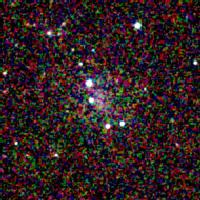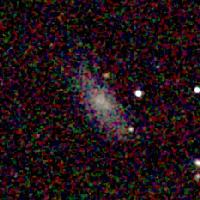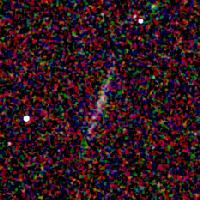


vii. XSC -- Virgo Galaxy Cluster: Low-Resolution, 50 deg2 Large Mosaic
In order to test the XSC completeness on a much larger scale, we employ a large mosaic with low spatial resolution. The mosaic has been binned to 3´´×3´´ pixels, covering 9300 × 7200 pixels, for a full field-of-view of 7.8°×6°. In Figure 1 we the color composite JHKs image.
The Virgo mosaic was split into 99 pieces, each 800×800 pixels (approximately 40´ on a side). In Figures 1-99, in Table 1 below, the extended sources from the working database are indicated with blue circles, and the XSC sources are indicated with green circles. The subimages were then visually inspected, concentrating on clearly delineated Virgo galaxies which are not in the XSC (i.e., sources not circled in green). These sources (indicated with red circles) represent incompleteness in the XSC. (Items to note: "chaff" in proximity to large and bright galaxies is mostly eliminated from the XSC; artifacts from bright stars; airglow and background gradients; source confusion; faint or compact sources provide little, if any, information for this experiment.)
Table 2 presents the sources identified from the Virgo mosaic that do not have an XSC counterpart. The columns for the table are: (ip,jp), panel number, from Table 1 above; (x,y), pixel coordinates; (ra,dec), J2000 equatorial coordinates; radius, circular aperture radius in arcsec; J mag; J-band rms uncertainty; and, "zoomed" image.
Bottom Line: Most of the missing galaxies are low surface brightness, with SNR well below the Level-1 science requirements. With regard to clearly delineated galaxies (well-extended, diameters > 10´´-20´´), the XSC completeness requirement in Virgo is comfortably satisfied.
| Table 2 | ||||||||||||
| IP | JP | x | y | ra | dec | radius | ba | pa | ib | mag | msig | image |
|---|---|---|---|---|---|---|---|---|---|---|---|---|
| 2 | 1 | 1574.0 | 6789.0 | 189.89700 | 16.09676 | 10.0 | 1.000 | 0.0 | j | 10.602 | 0.017 | Figure 100 |
| 2 | 1 | 1011.0 | 6611.0 | 190.38402 | 15.94341 | 10.0 | 1.000 | 0.0 | j | 15.303 | 0.531 | Figure 101 |
| 5 | 1 | 3271.0 | 6687.0 | 188.42320 | 16.02272 | 10.0 | 1.000 | 0.0 | j | 12.536 | 0.044 | Figure 102 |
| 9 | 1 | 6851.0 | 7020.0 | 185.31224 | 16.29564 | 10.0 | 1.000 | 0.0 | j | 11.401 | 0.021 | Figure 103 |
| 1 | 2 | 765.0 | 5968.0 | 190.58885 | 15.40313 | 10.0 | 1.000 | 0.0 | j | 10.759 | 0.017 | Figure 104 |
| 4 | 2 | 2993.0 | 6186.0 | 188.66069 | 15.60322 | 10.0 | 1.000 | 0.0 | j | 14.414 | 0.235 | Figure 105 |
| 5 | 2 | 3233.0 | 5663.0 | 188.45021 | 15.16779 | 30.0 | 1.000 | 0.0 | j | 10.960 | 0.033 | Figure 106 |
| 6 | 2 | 4043.0 | 6335.0 | 187.75063 | 15.73193 | 20.0 | 1.000 | 0.0 | j | 13.771 | 0.261 | Figure 107 |
| 8 | 2 | 6062.0 | 5873.0 | 186.00397 | 15.34307 | 10.0 | 1.000 | 0.0 | j | 11.494 | 0.022 | Figure 108 |
| 11 | 2 | 8577.0 | 6120.0 | 183.82355 | 15.52952 | 10.0 | 1.000 | 0.0 | j | 10.812 | 0.017 | Figure 109 |
| 2 | 3 | 1046.0 | 5122.0 | 190.33504 | 14.70030 | 20.0 | 1.000 | 0.0 | j | 13.029 | 0.132 | Figure 110 |
| 2 | 3 | 1340.0 | 5136.0 | 190.08134 | 14.71495 | 20.0 | 1.000 | 0.0 | j | 13.335 | 0.175 | Figure 111 |
| 3 | 3 | 2365.0 | 5156.0 | 189.19589 | 14.74003 | 10.0 | 1.000 | 0.0 | j | 14.758 | 0.322 | Figure 112 |
| 4 | 3 | 2933.0 | 5435.0 | 188.70737 | 14.97699 | 10.0 | 1.000 | 0.0 | j | 11.185 | 0.019 | Figure 113 |
| 6 | 3 | 4406.0 | 5488.0 | 187.43617 | 15.02460 | 10.0 | 1.000 | 0.0 | j | 14.632 | 0.287 | Figure 114 |
| 7 | 3 | 5551.0 | 5403.0 | 186.44835 | 14.95258 | 10.0 | 1.000 | 0.0 | j | 14.185 | 0.190 | Figure 115 |
| 8 | 3 | 5951.0 | 5550.0 | 186.10144 | 15.07395 | 10.0 | 1.000 | 0.0 | j | 14.456 | 0.244 | Figure 116 |
| 1 | 4 | 669.0 | 4715.0 | 190.65535 | 14.35658 | 30.0 | 1.000 | 0.0 | j | 12.044 | 0.082 | Figure 117 |
| 2 | 4 | 867.0 | 4013.0 | 190.47626 | 13.77326 | 20.0 | 1.000 | 0.0 | j | 13.056 | 0.135 | Figure 118 |
| 3 | 4 | 1871.0 | 4364.0 | 189.61604 | 14.07648 | 10.0 | 1.000 | 0.0 | j | 14.797 | 0.334 | Figure 119 |
| 4 | 4 | 2673.0 | 4238.0 | 188.92514 | 13.97610 | 10.0 | 1.000 | 0.0 | j | 16.289 | 1.317 | Figure 120 |
| 5 | 4 | 3942.0 | 4398.0 | 187.83443 | 14.11453 | 20.0 | 1.000 | 0.0 | j | 13.147 | 0.147 | Figure 121 |
| 7 | 4 | 5117.0 | 4438.0 | 186.82368 | 14.14832 | 10.0 | 1.000 | 0.0 | j | 9.619 | 0.015 | Figure 122 |
| 9 | 4 | 7050.0 | 4786.0 | 185.15776 | 14.43055 | 10.0 | 1.000 | 0.0 | j | 10.427 | 0.016 | Figure 123 |
| 9 | 4 | 6687.0 | 4716.0 | 185.47018 | 14.37450 | 10.0 | 1.000 | 0.0 | j | 11.664 | 0.024 | Figure 124 |
| 10 | 4 | 7519.0 | 4253.0 | 184.75838 | 13.98232 | 20.0 | 1.000 | 0.0 | j | 13.552 | 0.213 | Figure 125 |
| 3 | 5 | 2367.0 | 3381.0 | 189.18237 | 13.25933 | 20.0 | 1.000 | 0.0 | j | 11.469 | 0.035 | Figure 126 |
| 4 | 5 | 2877.0 | 3742.0 | 188.74702 | 13.56346 | 10.0 | 1.000 | 0.0 | j | 12.157 | 0.033 | Figure 127 |
| 4 | 5 | 2434.0 | 3836.0 | 189.12794 | 13.63930 | 10.0 | 1.000 | 0.0 | j | 15.003 | 0.403 | Figure 128 |
| 7 | 5 | 5229.0 | 3739.0 | 186.72859 | 13.56505 | 10.0 | 1.000 | 0.0 | j | 14.515 | 0.258 | Figure 129 |
| 7 | 5 | 5543.0 | 3299.0 | 186.46030 | 13.19734 | 10.0 | 1.000 | 0.0 | j | 14.779 | 0.328 | Figure 130 |
| 8 | 5 | 6194.0 | 3647.0 | 185.90085 | 13.48533 | 10.0 | 1.000 | 0.0 | j | 10.377 | 0.016 | Figure 131 |
| 8 | 5 | 5625.0 | 3335.0 | 186.38992 | 13.22715 | 10.0 | 1.000 | 0.0 | j | 14.781 | 0.329 | Figure 132 |
| 11 | 5 | 8524.0 | 3829.0 | 183.89851 | 13.61878 | 10.0 | 1.000 | 0.0 | j | 14.737 | 0.316 | Figure 133 |
| 11 | 5 | 8723.0 | 3643.0 | 183.72972 | 13.46134 | 20.0 | 1.000 | 0.0 | j | 13.856 | 0.282 | Figure 134 |
| 1 | 6 | 681.0 | 2418.0 | 190.61783 | 12.43990 | 10.0 | 1.000 | 0.0 | j | 15.155 | 0.464 | Figure 135 |
| 5 | 6 | 3787.0 | 2651.0 | 187.96327 | 12.65685 | 20.0 | 1.000 | 0.0 | j | 13.182 | 0.152 | Figure 136 |
| 5 | 6 | 3547.0 | 2789.0 | 188.16890 | 12.77129 | 30.0 | 1.000 | 0.0 | j | 12.976 | 0.190 | Figure 137 |
| 5 | 6 | 3782.0 | 2441.0 | 187.96704 | 12.48164 | 10.0 | 1.000 | 0.0 | j | 14.451 | 0.243 | Figure 138 |
| 6 | 6 | 4141.0 | 2632.0 | 187.66058 | 12.64171 | 10.0 | 1.000 | 0.0 | j | 11.172 | 0.019 | Figure 139 |
| 7 | 6 | 4882.0 | 2938.0 | 187.02690 | 12.89728 | 10.0 | 1.000 | 0.0 | j | 14.686 | 0.301 | Figure 140 |
| 6 | 6 | 4777.0 | 2850.0 | 187.11679 | 12.82392 | 10.0 | 1.000 | 0.0 | j | 13.853 | 0.141 | Figure 141 |
| 7 | 6 | 5305.0 | 2479.0 | 186.66576 | 12.51382 | 10.0 | 1.000 | 0.0 | j | 14.278 | 0.207 | Figure 142 |
| 2 | 7 | 916.0 | 2183.0 | 190.41440 | 12.24731 | 20.0 | 1.000 | 0.0 | j | 13.628 | 0.229 | Figure 143 |
| 3 | 7 | 2171.0 | 2217.0 | 189.34230 | 12.28696 | 20.0 | 1.000 | 0.0 | j | 13.936 | 0.304 | Figure 144 |
| 10 | 7 | 7967.0 | 2346.0 | 184.39139 | 12.38756 | 30.0 | 1.000 | 0.0 | j | 13.547 | 0.320 | Figure 145 |
| 1 | 8 | 168.0 | 911.0 | 191.03928 | 11.17695 | 20.0 | 1.000 | 0.0 | j | 13.955 | 0.309 | Figure 146 |
| 8 | 8 | 5713.0 | 1393.0 | 186.32016 | 11.60663 | 10.0 | 1.000 | 0.0 | e | 14.832 | 0.344 | Figure 147 |
| 1 | 9 | 509.0 | 314.0 | 190.74284 | 10.68192 | 10.0 | 1.000 | 0.0 | j | 14.817 | 0.340 | Figure 148 |
| 2 | 9 | 1119.0 | 59.0 | 190.22218 | 10.47653 | 30.0 | 1.000 | 0.0 | j | 13.664 | 0.357 | Figure 149 |
| 3 | 9 | 2369.0 | 796.0 | 189.16568 | 11.10242 | 20.0 | 1.000 | 0.0 | j | 13.709 | 0.246 | Figure 150 |
| 4 | 9 | 2578.0 | 595.0 | 188.98608 | 10.93676 | 20.0 | 1.000 | 0.0 | j | 14.755 | 0.645 | Figure 151 |
| 5 | 9 | 3376.0 | 581.0 | 188.30785 | 10.92808 | 10.0 | 1.000 | 0.0 | j | 15.073 | 0.430 | Figure 152 |
| 7 | 9 | 5101.0 | 504.0 | 186.84235 | 10.86667 | 20.0 | 1.000 | 0.0 | j | 12.302 | 0.069 | Figure 153 |
| 7 | 9 | 5236.0 | 264.0 | 186.72801 | 10.66521 | 30.0 | 1.000 | 0.0 | j | 13.658 | 0.355 | Figure 154 |
| 11 | 9 | 8516.0 | 331.0 | 183.94168 | 10.70014 | 30.0 | 1.000 | 0.0 | j | 13.580 | 0.330 | Figure 155 |
The following figures show some of the largest Virgo galaxies missing from the XSC. The images belong to the 2MASS Large Galaxy Atlas (LGA), and the integrated fluxes come from the LGA. Note that even these "large" examples are low surface brightness. Figure 156 shows NGC 4523, with isophotal size and mags (r, J, H, Ks)= 25.5´´, 13.014±0.049, 12.392±0.074, 12.155±0.086 mag; image size = 4.8´×4.8´. Figure 157 shows NGC 4633, with isophotal size and mags (r, J, H, Ks)=30.8´´, 12.234±0.032, 11.573±0.043, 11.382±0.054 mag; image size = 3.9´×3.9´. Figure 158 shows IC 3074, with isophotal size and mags (r, J, H, Ks)=21.2´´, 13.914±0.091, 13.396±0.121, 12.984±0.160 mag; image size = 3.9´×3.9´.
 |
 |
 |
| Figure 156 | Figure 157 | Figure 158 |
See IV.5a8. Use the full-resolution (1´´ pixel) mosaic of the "heart of Virgo" (approximately 1.4° × 1.4°) to investigate the completeness of the fainter, more compact population. Here, it would be useful to overlay existing catalogs (via NED) to glean the maximum sensitivity of the 2MASS images.
[Last Updated: 2002 Oct 9 ; by T. Jarrett]